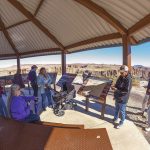
50 years ago: Navajos debate going into the underwear business

Navajo Hipster panties that Urban Outfitters had marketed in 2014.
It’s kind of interesting to note that the Navajo Nation is seeking millions of dollars from Urban Outfitters for the money they have made during the past three decades selling clothing inspired by Navajo designs.
It’s interesting because 50 years ago this week, there was another debate going on within the Navajo Nation Council and it also concerned clothing.
The tribe had received an offer from BVD Corporation to build a plant on the Navajo Reservation to make clothing using Navajo labor.
The BIA, the tribe and the company had set up a pilot plant near Winslow to see whether Navajo women could adapt to high-speed apparel manufacturing operations.
BVD officials said last year that this kind of operations isn’t for everyone, pointing out that it is repetitious and boring a lot of the time and the workers need to be willing to work under hard conditions for $2.00 to $2.50 an hour or so.
A report issued by the company in December 1965, praised Navajo women saying “preliminary reports indicate that the Navajo women have the dexterity and the adaptability to this work.”
Company officials said they were very satisfied with the work being done by the Navajo women at the Winslow plant and wanted to establish one or more plants in various places on the Navajo Reservation to manufacture clothing.
What attracted company officials in the first place were the stories they heard about the patience of Navajo rug weavers who would spend months making a beautiful rug. They also pointed out that Navajo rug weavers had the ability to keep the design of their rug in the back of their minds at all time so that they could make elaborate designs that was amazing to behold.
While the BVD products, which mainly centered around underwear, wasn’t that elaborate, company officials said the ability to imagine what a product would look like when one started the manufacturing was a big plus in their business.
There was even talk of coming out with products that showed the Navajo influence although from the articles that were printed in the Navajo Times and other publications, no one in the tribe or in the company was saying anything about using Navajo designs on the company’s underwear – solid white was their best selling product.
What the company wanted, it appears, was a partner and a lot of discussion went on within the Navajo Tribal Council as to whether they wanted to partner with the company, although it would mean a lot of jobs to a segment of the Navajo population – women -who had a hard time finding jobs on the reservation.
The company pointed out that it already had several plants located throughout the United States and Puerto Rico and these were all very successful.
This is a time when a lot of young Navajo women were answering ads in the area publications urging the to sign up for jobs in Los Angeles and other big cities to become housemaids or nannies to wealthy families who wanted an Indian woman to work for them.
The articles seem to indicate that most members of the council were in favor of the idea. What many of them were concerned about was the desire of the BVD company for the tribe to build the plant and buy the equipment.
For this, all the tribe would get was jobs for its female members. The tribe would not be a partner and would not share in the profits. Tribal leaders would have no say in how much the company would pay or any of its policies.
The BIA was definitely in favor of the project, seeing it as a way to improve the economy on the reservation. The BIA was even willing, to a limited extent, to use federal dollars to help with the plant construction.
The proposal before the council this week was not to approve or disapprove the proposal but whether to allow the tribe’s Advisory Committee to negotiate and make a decision on behalf of the tribe whether than waiting for the tribal council to do it.
After all, it’s easier for a 12-member body to make a decision rather than the 72 members the Navajo council had at that time.
After three days of discussion, the council bit the bullet and agreed to allow the committee to negotiate with the company. However, if the final proposal called for the tribe to put up any money to build a plant or buy equipment, that part would have to go before the entire council for approval.
In political news on the reservation, Sam Billison, director of the tribe’s public services division, said he planned to hold a rally in Tuba City on March 11 and officially announce that he plans to run for tribal chairman against Raymond Nakai, the current chairman.
Billison ran against Nakai and the current chairman at the time, Paul Jones, just three years before and now figured he could defeat Nakai because his popularity was hurt because of all of the infighting between him and the Old Guard on the tribal council.
Billison had a rally of sorts just about a month ago and some 2,000 Navajos showed up, which gave him the idea of another campaign would attract thousands of supporters.
To read the full article, pick up your copy of the Navajo Times at your nearest newsstand Thursday mornings!
Are you a digital subscriber? Read the most recent three weeks of stories by logging in to your online account.








 Highway 264,
Highway 264, I-40, WB @ Winslow
I-40, WB @ Winslow